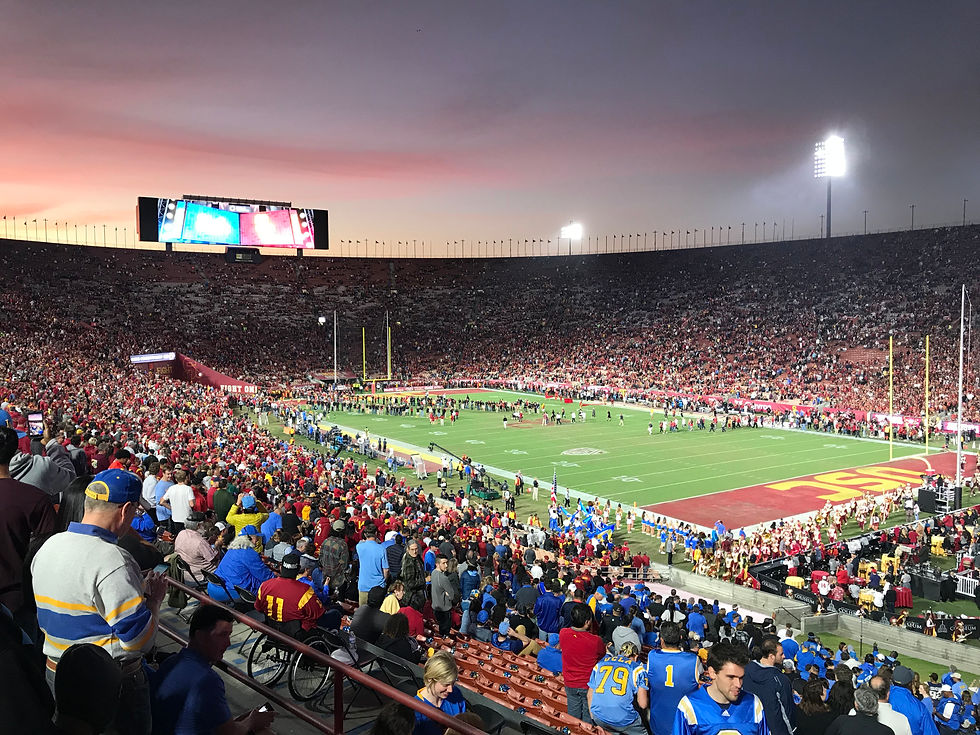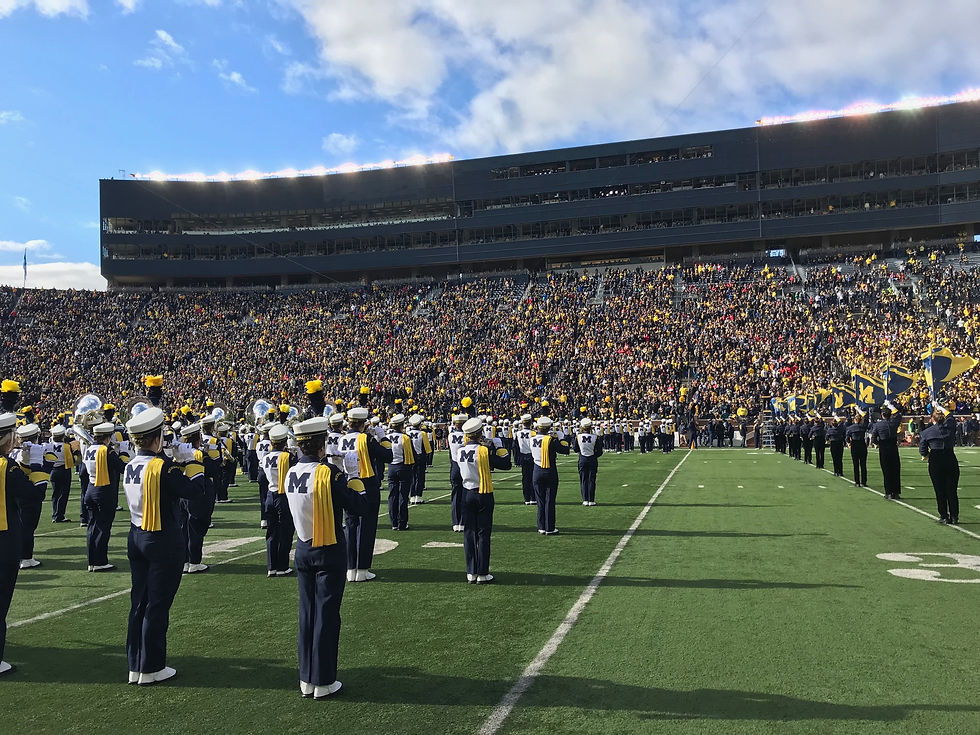Manifest Destiny: The REALLY Big Ten
- paternojay
- Jul 14, 2022
- 8 min read
The REALLY Big Ten has now fulfilled a true "Manifest Destiny"; a TV empire reaching from Coast to Coast. From New Jersey (Rutgers) to Southern California (USC & UCLA) "This is Big Ten Country."

Now that initial seismic earthquake activity of the USC and UCLA announcement has settled into a series of rolling minor aftershocks, it is time to survey the altered college football landscape.
And just like earthquakes no one can be completely sure when the next one comes. We know the likely fault lines involve the remaining Pac 10 teams and Big 12 teams. With that in mind, what is written here is valid only as long as the Big Ten remains at 16 teams which could be an hour, a day a year….who knows?
PART 1: SO HOW DID WE GET HERE ?
In 1977 a number of schools joined together to try to maximize their television revenue in reaction to the NCAA’s tight control on broadcast rights. By 1981 they’d set up a television contract that would broadly benefit schools across the country. That group was called the College Football Association (CFA) and it included The SEC, The ACC, The Big 8, The Southwest Conference, The Western Athletic Conference as well as Penn State, Notre Dame, Pitt, West Virginia, Army, Navy and Air Force. Only the Pac 8 and the Big 10 did not join.
After a protracted legal battle in 1984 the Supreme Court shattered the NCAA’s monopoly hold on television rights for college sports. By the end of the decade (1989), Penn State announced it was headed to the Big Ten in 1993 beginning a run of conference alignment that has lasted thirty-three years. Less than two years later Notre Dame left the CFA and signed a deal with NBC Sports.
Then it became every conference for themselves. Conference commissioners and university Presidents looked to get the biggest TV contracts they could, creating an imbalance in the payouts from one conference to another.
Ultimately it is all about the TV money and creating programming that is relevant in as many big TV markets as possible. In the latest run of realignment Texas and Oklahoma saw bigger paydays in the SEC and now USC and UCLA found GREENER pastures in the Big 10. The SEC strengthens its hand in the Houston, San Antonio, Oklahoma City, Austin and Dallas/Ft Worth markets. The Big Ten picks up the massive LA market and markets across California.
PART 2: WHAT MIGHT THIS ALL LOOK LIKE IN FOOTBALL?
So if the Big Ten stays put let’s survey what 16 teams could mean for football scheduling.
The easy solution is to put USC and UCLA in the West and slide Purdue to the East. That at least gets all your Eastern time zone teams in one division and all your Central and Pacific time zone teams in the West.
Some have suggested four scheduling “pods” but that creates problems. Without divisions you could end up with an undefeated team followed by two or three teams with two losses that did not play each other. Who gets the second spot in the championship game?
If you set up two divisions, you play 7 division games and then by alternating 2 different crossover games every year you will play everyone in the other division once every 4 years. And as far as locked-in rivalry games, the Purdue to the East move makes all those rivalry games annually guaranteed division games.
But will the television networks be okay with Ohio State playing USC only once every 4 years?
If you space them the right way you could get for example USC at Ohio State in 2024, USC hosting Penn State in 2025 , USC at Michigan in 2026, and USC hosting Michigan State in 2027. At the same time you could have UCLA at Penn State in 2024, UCLA hosting Ohio State in 2025, UCLA at Michigan State in 2026 and UCLA hosting Michigan in 2027. The next four years successive years you flip the home stadiums.
If the Big Ten stops at USC and UCLA and goes with two divisions, current Big Ten football teams will have likely have at most one west coast trip per year maybe two for the western division teams. But UCLA and USC could be making 4 or 5 trips east.
In the current 16-team model, UCLA and USC will be playing 4 to 5 of their 9 conference games at 2 or 3 time zones away from their Pacific Time Zone in LA. Depending on their non-conference schedules it could be more.
So, using the already announced non-conference games for USC and UCLA, here’s a look at what UCLA’s schedule could look like in 2024, and USC’s schedule in 2026.
2024 UCLA Possible Schedule
8/31 at Hawaii
9/14 FRESNO STATE
9/21 at LSU
9/28 NEBRASKA
10/5 at Iowa
10/12 NORTHWESTERN
10/19 ILLINOIS
10/26 WISCONSIN
11/2 at Penn State
11/9 MARYLAND
11/16 at Minnesota
11/23 USC
2026 USC Possible Schedule
9/5 FRESNO STATE
9/12 MINNESOTA
9/19 at Ole Miss
10/3 NORTHWESTERN
10/10 at Michigan
10/17 IOWA
10/24 at Illinois
10/31 RUTGERS
11/7 at Wisconsin
11/14 NEBRASKA
11/21 at UCLA
11/28 NOTRE DAME
In 2024 that UCLA schedule would give them 5 games at 2 or more time zones away (we’ll call them “distance games”). Total air travel would amount to just around 19,000 miles averaging 3,800 roundtrip miles. As for USC in 2026 they play at Ole Miss and this sample schedule would give them 4 distance games.
By comparison in this year’s NFL schedule only 4 teams play four or more distance games. And these are spread out across 18 weeks. These are highly paid pros without schoolwork. (Of course, this could all change if the Big Ten adds more west coast teams. But that creates a whole other set of problems—so let’s not borrow tomorrow’s troubles for today).
And a lot of talk has centered on USC and UCLA playing games that kickoff at noon eastern time (9 a.m. Pacific time). But the flipside will be a team like Maryland playing a 7 p.m. Pacific kickoff time at UCLA. That means Maryland players are playing at 10 p.m. eastern time and finishing after 1 a.m. and getting home mid to late morning on Sunday after a 2300+ mile flight.
What this all means is that the Big Ten will be putting a lot of physical and mental demands on student-athletes.
And by adding that 7 p.m. time slot, the Big Ten now has four weekly time slots (noon, 3:30, primetime east and primetime west) they can offer over thirteen weeks. The potential slots just went from 39 Saturday slots per year to as many as 52. And at the end of the day, this is about TV markets, TV payouts and TV content.
PART 3: WHAT ABOUT OTHER SPORTS?
Football is the biggest and most obvious piece of the puzzle, but there are a number of other sports where the travel schedule and budgets just exploded.
In sports other than football, current Big Ten teams will be making one or two conference west coast trips per year. But what about USC and UCLA? From basketball to gymnastics, with sports like baseball, softball, golf, gymnastics, swimming, track, women’s volleyball, soccer and everything in between there will be a series of long trips every year.
UCLA’s baseball team will be traveling all over the place. USC’s women’s lacrosse team’s closest conference road game will be at Northwestern. UCLA’s women’s soccer team will be playing at places like Rutgers, Penn State and Maryland on a regular basis.
Unlike football and basketball most of these teams do not fly on chartered airplanes with police escorts to and from the airport. This means complicated connections or combined flights/bus trips from the West Coast to get to places like State College, Iowa City, Lansing, Madison, Bloomington, West Lafayette or Champaign.
These new TV contracts are going to have a cost in more than just increased travel expenses. There is time away from the classroom, time away from campus and demands that will require more tutoring, more support and probably more mental health challenges.
PART 4: WHAT REALLY SHOULD HAPPEN ?

There is a natural order to college football rivalries and schedules. The NFL is a national league, with national games. As strong as the NFL is, the passionate hate and rivalries are not as strong there as they are in college football.
College football’s passion, tradition and intensity are born of proximity, of regional rivalries, of history intertwined with one another. Adding west coast teams to the Big Ten will not replicate the underlying foundations of college football’s greatest strength. Michigan and Ohio State border each other and they hate each other. That scenario is replicated all over the country in other rivalries.
To calm the shifting landscape, what college football needs is something along the lines of the old CFA group to emerge.
The irony is this; it was the NCAA’s control and greed that created the legal earthquake that freed up television rights. Now conferences’ control and greed are creating an explosive situation that likely ends with litigation blowing up the amateur college sports model.
As the new round of television contracts come in with numbers in the billions of dollars, revenue sharing with student-athletes will certainly follow. We may not like it, but the courts will dictate it. That creates more realignment pressure as teams clamor to join conferences with higher revenues to share with higher pay for high-profile recruits.
If the conferences would agree to an NFL-style set of national television contracts that split television revenues more evenly among the Power-5 conferences, realignment can resettle into more traditional conference alignments. UCLA and USC could remain out west.
More even national distribution of revenues would help keep the game healthy in more regions around the country. Domination by one or two competing leagues and competing networks may be good for television and for those conferences in the near term.
But ultimately the erosion of the soil in which college football’s tradition is rooted will be bad for the long-term health of the game. Ideally teams should stay in their natural home conferences with geographic rivalries in football, basketball and every other sport.
In college football tradition matters. Even as Penn State heads into its 30th football season in the Big Ten, the Nittany Lions have yet to develop a full-blown rivalry game. No matter what anyone says, that is a hole that remains.
PART 5: WHAT WILL ACTUALLY HAPPEN?
Greed rules the day right now. Creating financial imbalances which some see as potentially fueling competitive imbalances are the criteria upon which conference commissioners are judged. They get rewarded for bigger and bigger TV checks.
And like the middle-aged man compensating for something by buying an expensive sports car, conferences love to tout the size of their TV paychecks as a badge of relevance.
That narrow thinking leads to a path to a place we may not like.
But don't blame the conference commissioners. This is what they’re being asked to do. And as the salaries for coaches, administrators and bloated staffs grow, TV money has to put enough slop in every school’s trough for feeding time. And while the employees are feeding at that trough, the student-athletes that have been nosed out will start to organize.
So, in what will be a full circle moment, the student-athletes will pretty soon get a case to the same Supreme Court that created the TV rights monster we have now. And that Supreme Court will see the money and see the greed and see that the labors of these student-athletes are benefitting coaches, administrators and television networks. And that same Supreme Court will forever upend the model of college sports.
The irony should not be lost on anyone. The greed of the NCAA in the 1970s birthed an inequitable system that put power in the hands of the conferences. And their unending chase to ensure massive television payoffs and the inequitable distribution of TV money will ultimately be the downfall of the system for all.
And for the REALLY Big Ten the end result of their Manifest Destiny may be a destiny they never really wanted.

























Comments